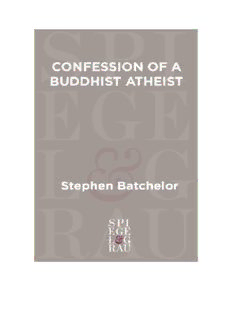
Confession of a Buddhist Atheist PDF
Preview Confession of a Buddhist Atheist
ALSO BY STEPHEN BATCHELOR Alone with Others: An Existential Approach to Buddhism The Faith to Doubt: Glimpses of Buddhist Uncertainty The Tibet Guide: Central and Western Tibet The Awakening of the West: The Encounter of Buddhism and Western Culture Buddhism Without Beliefs: A Contemporary Guide to Awakening Verses from the Center: A Buddhist Vision of the Sublime Living with the Devil: A Meditation on Good and Evil There are not only one hundred, or five hundred, but far more men and women lay followers, my disciples, clothed in white, enjoying sensual pleasures, who carry out my instruction, respond to my advice, have gone beyond doubt, become free from perplexity, gained intrepidity and become independent of others in my teaching. —Siddhattha Gotama ——— Stories are impossible but it’s impossible to live without them. That’s the mess I’m in. —Wim Wenders PREFACE Confession of a Buddhist Atheist tells the story of a thirty-seven-year journey through the Buddhist tradition. It begins with my encounter in India at the age of nineteen with the Dalai Lama and the teachings of Tibetan Buddhism, and concludes with the reflections of a fifty-six-year-old secular, nondenominational lay Buddhist living in rural France. Since I was not raised as a Buddhist, this is a story of conversion. It tells of my fascination with Buddhism as well as my struggle to come to terms with doctrines—such as reincarnation—that I find difficult to accept, and authoritarian religious institutions that resist criticism and innovation. My personal struggles may also reflect a broader cultural conflict between the worldview of a traditional Asian religion and the intuitions of secular modernity. My encounter with traditional forms of Buddhism led me to ask with increasing urgency: Who was this man Siddhattha Gotama, the Buddha? What sort of world did he live in? What was distinctive and original in his teaching? I began to realize that much of what was presented to me in good faith as “Buddhism” were doctrines and practices that had evolved many centuries after the Buddha’s death, under very different circumstances from those in which he lived. Throughout its history Buddhism has displayed a remarkable ability to adapt to novel situations and reinvent itself in forms appropriate to the needs of its new adherents. Yet this very ability to present itself in another guise has also served to obscure the origins of the tradition and the figure of its founder. In many schools of Buddhism today, the discourses of Siddhattha Gotama are rarely studied, while the man himself is often elevated to the status of a god. My quest to trace the origins of Buddhism led me to the study of the Pali Canon: the body of teachings attributed to Siddhattha Gotama in the ancient Pali language. While these texts are not verbatim transcripts of what the Buddha said, they preserve the earliest elements of his teaching and provide glimpses into the fraught social and political milieu of his world. This quest also took me back to India to visit those places mentioned in the Pali Canon where the Buddha lived and taught nearly twenty-five hundred years ago. These studies and field trips, together with G. P. Malalasekera’s invaluable Dictionary of Pali Proper Names, have enabled me to reconstruct an account of the Buddha’s life that is embedded in his relations with his benefactors, family, and disciples and formed by the political and social tensions of his time. Many of the people who appear in this book are or were Buddhist monks. Yet the term “monk” (or “nun”) in Buddhism does not mean quite the same thing that it does when used in a Christian context. The Pali word for “monk” is bhikkhu, which literally means “beggar.” (“Nun” is bhikkhuni, which means the same.) A bhikkhu or bhikkhuni is one who has dropped out of mainstream society in order to devote him- or herself to the practice of the Buddha’s teaching. On receiving ordination, bhikkhus and bhikkhunis take more than two hundred vows (many of them minute behavioral conventions). They commit themselves to a life of chastity and poverty but—traditionally at least—are encouraged to lead a wandering life and survive by begging alms. In addition to pursuing a life of simplicity, solitude, and contemplation, the bhikkhu or bhikkhuni will also teach when invited to do so, and provide counseling and pastoral care to those in need. Buddhism makes no distinction between a monk and a priest. I was a Buddhist monk (initially a novice, then a bhikkhu) for ten years; since disrobing, I have lived as a married layman. Because I do not belong to any Buddhist institution or tradition, I have no “home” in the Buddhist world. I have become a freelance itinerant teacher, traveling to wherever in the world I am invited to share what I have learned. Confession of a Buddhist Atheist is written from the perspective of a committed layperson who seeks to lead a life that embodies Buddhist values within the context of secularism and modernity. I have no interest in preserving the dogmas and institutions of traditional Asian forms of Buddhism as though they possessed an intrinsic value independent of the conditions under which they arose. For me, Buddhism is like a living organism. If it is to flourish outside self-enclosed ghettos of believers, it will have to meet the challenge of understanding, interacting with, and adapting to an environment that is strikingly different from those in which it has evolved. Since this book is intended for the general reader, I have omitted all diacritical marks on Pali terms. These are, however, included in the notes, appendixes, and glossary. STEPHEN BATCHELOR Aquitaine September 2009 CONTENTS Preface PART ONE: MONK 1. A Buddhist Failure (I) 2. On the Road 3. The Seminarian 4. Eel Wriggling 5. Being-in-the-World 6. Great Doubt PART TWO: LAYMAN 7. A Buddhist Failure (II) 8. Siddhattha Gotama 9. The North Road 10. Against the Stream
Description: